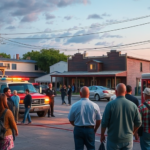Juvenile Justice Concerns Rise Amidst Increasing Youth Offenses in Cameron County
The Cameron County juvenile justice system is facing mounting challenges as authorities grapple with an alarming rise in crimes committed by youth, some as young as ten years old. This concerning trend underscores the urgent need for effective intervention strategies to address juvenile delinquency in the region.
Increasing Youth Offenses Pose Significant Challenges
Nestled in San Benito, Texas, the Darrell B. Hester Juvenile Detention Center has become a focal point for handling youth offenses in Cameron County. The center now houses boys and girls aged 10 to 16, who are accused of various crimes ranging from misdemeanors to felonies. The severity of their charges dictates their stay, which can range from 10-15 days for misdemeanors to two or more months for more serious offenses.
Michael Martinez, Deputy Director of the detention center, explained, “If it’s a misdemeanor, it could be 10 days, 15 days,” adding that for repeat offenders or those charged with felonies, stays can extend much longer.
Staff at the center work tirelessly around the clock to monitor and ensure the safety of these young individuals, preventing them from self-harm or harming others. “It’s about providing a secure environment where they can rehabilitate,” said Martinez.
Capacity Struggles Amidst Construction and Increased Referrals
One major issue plaguing the detention center is capacity, compounded by an ongoing construction project aimed at expanding its facilities. The center has already seen a significant increase in juvenile referrals since early 2025, pushing its limits and posing logistical challenges.
The increased capacity is intended to accommodate the rising numbers, partly prompted by a worrying trend of repeat offenses, particularly in theft and possession of controlled substances. Records show a jump in theft cases from 36 incidents in 2022 to 54 in 2024. Similarly, possession cases have surged from 200 to 247 during the same period. These statistics highlight an undeniable trend that regional authorities must address promptly and effectively.
Community Impact: Addressing the Root Causes of Youth Crime
The implications of these increasing juvenile offenses extend beyond the juvenile justice system, touching families, schools, and the broader community in the Rio Grande Valley. As such, understanding and tackling the root causes, ranging from economic disparities to lack of access to education and social services, becomes imperative.
Community leaders and experts argue that without addressing these foundational issues, the cycle of juvenile offenses will persist. “We need a multi-pronged approach that includes family support, education, and community engagement to provide our youth with the opportunities they need to succeed,” advocacy group leader Luisa Gonzalez emphasized.
Local schools, such as the San Benito Independent School District, play a critical role in these efforts by providing educational programs within the detention center, allowing young detainees to continue their academic journey under supervision.
Connections to Ongoing Community Issues
The increasing number of juvenile offenses in Cameron County is part of broader societal issues, including a spike in violent crimes and other serious incidents, such as the recent arrest related to a fatal stabbing outside a Brownsville funeral home. Efforts to curb these trends often intersect with other community events, like recent discussions around Progreso ISD Board governance following the DWI arrest of Board President Juan Jose Ramos.
Further compounding societal challenges are weather conditions necessitating public advisories such as those issued for spotty showers with temperatures in the 90s. The community resources like McAllen’s cooling centers and other safety initiatives remain crucial.
Moving Forward: Strategic Interventions and Resources
Addressing the juvenile crime surge is not an isolated task. It requires the collaboration of law enforcement, social services, local governments, and the communities they serve. Proactive measures and tailored interventions could significantly curtail this rising trend, potentially garnering partnerships with advocacy groups, local businesses, and educational institutions to offer mentorship and employment opportunities for at-risk youth.
For those looking to engage further on juvenile justice issues in Cameron County, resources include viewing full programming and updates on Channel 5 News and engaging with local agencies. The focus on rehabilitation at centers like Darrell B. Hester underscores how crucial it is to offer a second chance to these young individuals through structured support and guidance.
As the community comes together to tackle these pressing challenges, the overarching goal remains to foster a safer, more nurturing environment for the youth of the Rio Grande Valley, thereby setting the foundation for a more prosperous community.







